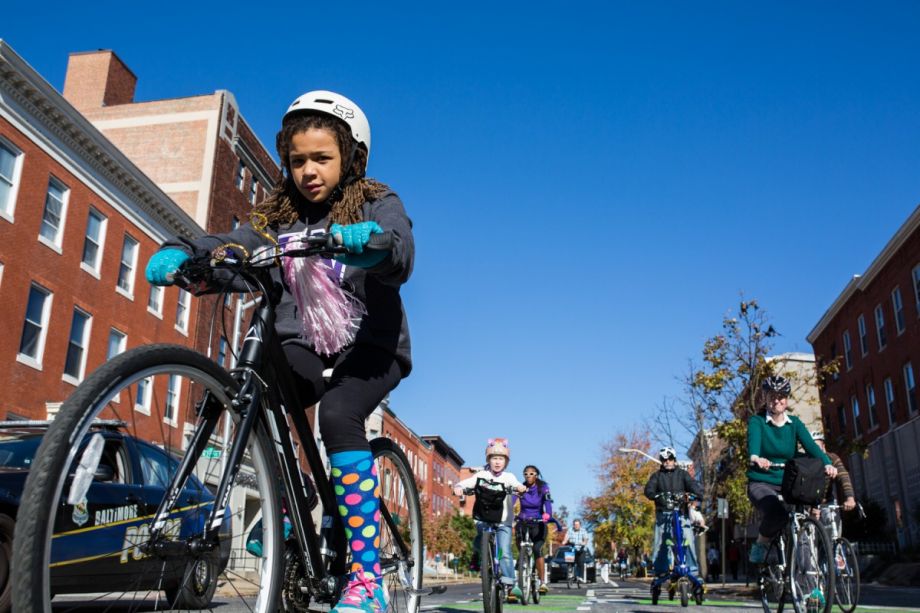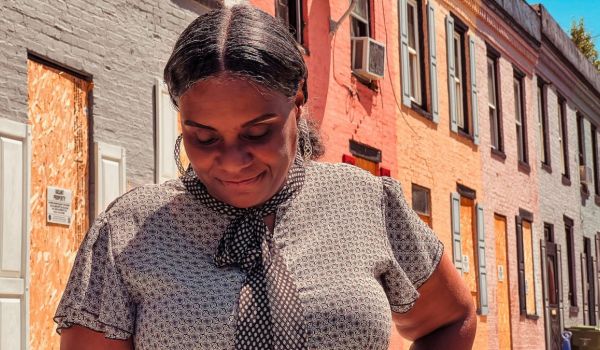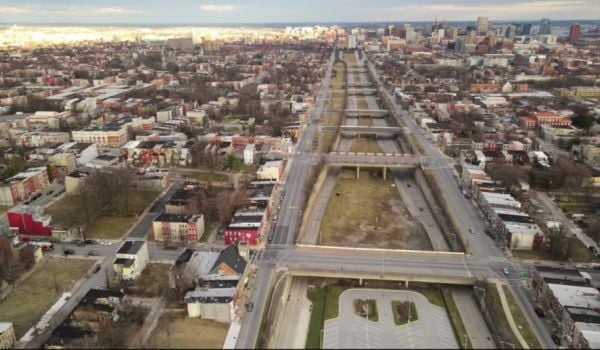On a warm, sunny afternoon in mid-June, longtime bike advocate Liz Cornish was returning home from a Baltimore City Council hearing when she noticed a large tiller fire truck — the kind with a secondary steering wheel for its tail end — parked in front of her house on Maryland Avenue in central Baltimore. Five higher-ranking Fire Department officials were also there, not responding to an emergency, but participating in the filming of a video intended to highlight the obstacles that bike lanes pose to emergency vehicle access.
“I recognized it immediately as a [fire] truck I had never seen in my neighborhood before,” Cornish recalls. “I was taken aback and I was angry because it really looked like clear intimidation.”
The incident became linked to a few verbal and physical bouts of fighting over the past year between Baltimore fire authorities, local residents, and cyclist advocates over a bike lane along Potomac Street in southeastern Baltimore. Shortly after its construction began in spring 2017, the bike lane became the center of controversy when area residents and members of the city’s Fire Department alleged that it would take up precious street space from emergency vehicles.
The firestorm caused Baltimore legislators to introduce a bill that would loosen urban design guidelines of the city’s fire code with the goal of lessening the regulatory hurdles to new bike lanes and private development projects. They approved the bill this month.
The fire code amendment bill, which will likely become law in late October, revokes a section of Baltimore’s fire code that requires at least 20-26 feet of clear street width for large fire apparatus during an emergency response. The clearance regulations would be supplanted by more flexible street design guidelines, from the National Association of City Transportation Officials, in order to facilitate approval of public infrastructure and private development projects.
Opponents of the Potomac Street bike lane viewed the lane as a safety hazard because, according to them, it would impede access to fires. Within a month of the start of construction, they petitioned the city’s Department of Transportation to cease completion of the two-way buffered lane. In June 2017, the city took heed and made plans remove the infrastructure it had only begun building two months prior.
“Initially, the department of transportation worked with the firehouse to make some minor adjustments [to the bike lane design],” says Cornish, executive director of Bikemore, a local cyclist advocacy organization. “Since that didn’t satisfy the opposition, the issue was brought to the fire marshal’s office, international fire code was invoked, and the city was going to stop work.”
Bikemore sued the city in an attempt to prevent the bike lane’s demolition, claiming that the application of the fire code’s clearance rule was “arbitrary and capricious.”
“Other projects [that entailed] changing parking configurations had been approved that didn’t meet the requirements of the fire code,” says Cornish. “As we continued to raise this issue for many months, the Fire Department’s response was not to work on a case-by-case basis to ensure public safety, but to become more strict about how they approved projects. And, it was clear that the city’s inaction had emboldened the firefighters.”
City Council Member Ryan Dorsey, vice chair of the council’s public safety committee and a member of the council’s land use and transportation committee, says the Fire Department’s public safety concerns were short-sighted — particularly since some 80 percent of emergency calls the department receives are about non-fire-related incidents. “The Fire Department has exhibited a narrow definition of public safety, one that looks essentially only at fire access,” says the council member.
Dorsey also notes that the Potomac Street controversy set a bad precedent for other public and private development projects around Baltimore.
“It impacted literally every other [development] project in the city for a year,” he says. “Other cycling infrastructure was not allowed to move forward, and some private development projects ended up having to modify their design to be substandard and, in some cases, less safe, in order to appease the Fire Department.”
Bikemore won a temporary restraining order that halted the bike lane’s demolition and proceeded to drop its lawsuit once the city agreed to keep the Potomac Street bike lane, which was finally completed last December. The bike organization and its supporters may have scored an even larger with the fire code amendment bill. City legislators expect the bill to go into effect on October 29.
The law is deemed a necessary legislative solution to the recurring dilemma of the city’s strict fire code standards impeding individual development and infrastructure projects, according to city councilman Eric Costello.
“This problem we’ve identified is extremely prevalent throughout the entire city,” says Costello, who chairs the council’s judiciary and legislative investigations committee. “We gave the Fire Department multiple options for ways to work with us, and they essentially said, ‘we’re still opposed to this bill’ — so, we moved forward with the bill.”
The fire department did not respond to requests for comment from Next City.
While Cornish believes the law is a result of a lack of effective leadership by the city and the Fire Department, she has hopes that it will lessen or eliminate the “competition” between fire safety and cyclist safety. “If we can design city streets that calm traffic and reduce the speed of cars,” she says, “we can reduce the number of times our emergency responders need to respond to [incidents].”
Bikemore’s rise to the forefront of Baltimore’s bike advocacy world was prompted by tragedy in late 2014, when Baltimore bike frame builder Thomas Palermo was struck and killed by a drunk driver. At the time, Baltimore’s streets had no protected lanes exclusively for bicycles, and politicians were virtually stagnant on taking steps to actively promote safe bike travel, according to Cornish.
While the road ahead looked steep, the need for change was perhaps more apparent than ever. “All of a sudden, there were all these people were so moved and were asking, ‘What can we do so this never happens again?’” Cornish says of Palermo’s death. “That began the advocacy movement.”
Bikemore first emerged in 2012 from an Alliance for Biking and Walking initiative and an Open Society Foundations grant, hiring an interim leader while launching a national search for an executive director. They found Cornish, a bike aficionado originally from Tulsa, Okla., who at the time managed the women bike division for the League of American Bicyclists in Washington, D.C.
“When I was hired in spring of 2015, it was just me, a little bit of money in a bank account, and a young, small board,” Cornish notes. “We had to grow very quickly as an organization and solidify its position as the authority and the voice of biking advocacy in the city.”
Bikemore’s chief goal quickly became to advocate for the realization of the Downtown Bike Network, a Baltimore Department of Transportation initiative that envisions a connected system of bike lanes in neighborhoods across the city. While the city had most of the necessary funds for the network’s construction, the political will to get the project going was virtually non-existent, says Cornish.
So she worked “aggressively” to cultivate relationships with representatives of state and city agencies in order to influence projects in the early stages of their development. “We just needed to get people in the same room so they could stop pointing fingers at each other about who would start the process,” she says. Later that year, Bikemore also launched its “IWalk, IRide Transit, IBike, IVote” campaign to mobilize the city’s bike advocates to cast votes for prospective city council members who support transportation equity.
Thanks to these types of advocacy efforts, and with the support of the Roland Park Civic League, the Baltimore Department of Transportation decided to include a two-way buffered bike lane along Roland Avenue as part of its resurfacing and traffic-calming project for the corridor. That bike lane was completed in December of 2015.
In late 2016, the Maryland Avenue bike lane also opened, and it earned a spot in PeopleforBikes’ top-ten best new bike lanes of the year. Cornish, who deems it the “crown jewel” of Baltimore’s bicycle infrastructure, witnesses local families with children using the bike lane to get to nearby Wyman Park. “I see firsthand how ridership volumes and diversity has changed,” she says. “You even see my elderly neighbors pushing their shopping carts down it.”
In just three years under Cornish’s leadership, Bikemore’s membership count has grown fivefold to more than 5,000 supporters, its operating budget has tripled in size from $90,000 to now $300,000, and the organization now has three full-time staff members.
As a woman in a male-dominated world of city politics, Cornish vows to continue fighting for more equitable, bike-oriented communities in Baltimore.
“I have a very, very tiny piece of the pie in the government that I’m responsible for advocating for,” she says, “but I have an opportunity to show that it’s possible to win.”
EDITOR’S NOTE: The original version of this article mis-stated Bikemore’s current budget. We’ve corrected the error.

Aline Reynolds is a New York-based journalist and urban planner. As a staff editor and reporter, she has chronicled the post-9/11 revitalization of Lower Manhattan, including the rebuilding of the World Trade Center. Her work has appeared in the American Planning Association’s Planning Magazine, Agence-France Presse, and Newsday.
.(JavaScript must be enabled to view this email address)
















